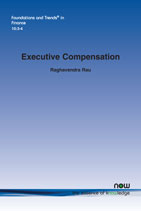Executive Compensation
By Raghavendra Rau, University of Cambridge, UK, r.rau@jbs.cam.ac.uk
Abstract
The optimal design of executive compensation is one of the primary issues in the area of corporate governance and has been investigated in considerable detail in the academic literature over the past three decades. The underlying assumption behind the design of optimal compensation schemes is that the executives of the firm have more information on the firm’s projects and cash flows than the shareholders. In the presence of symmetric information, since the shareholders can completely distinguish the executive’s effort from bad luck or other extraneous factors, there is little need to motivate the executive beyond a flat salary. In the presence of asymmetric information, the shareholder faces two problems: One, to select the right type of agent (the adverse selection problem) and two, to motivate the agent to work hard once selected (the moral hazard problem). All executive compensation schemes represent trade-offs between these two agency problems.
In this survey, in the first section, I start by discussing the theory of executive compensation. Why do firms pay executives? I distinguish two major approaches. The first arises from the theory of optimal compensation contracting and focuses on the composition of pay. It argues that the composition of pay is set to attract good executives (to solve the adverse selection problem) and motivate them to work hard (the moral hazard problem). The second approach focuses on the level of pay. It argues that managers have a considerable degree of power in setting their own wages, and in particular, use their power to extract excessive pay or rents from the shareholders. In the second section, I discuss the evidence on both the composition and level of pay and how it has changed over time, treating each component pay separately. I also discuss the composition of pay in countries around the world and in specific industries. In the third section, I describe who decides pay composition and levels. Finally, in the fourth section, I conclude by examining how the structure of pay has real consequences for firms
Executive Compensation
Executive Compensation surveys the extant literature on this important topic. The first section starts with a discussion of the theory of executive compensation, in which the author identifies two major approaches. The first arises from the theory of optimal compensation contracting and focuses on the composition of pay, arguing that the composition of pay is set to attract good executives (to solve the adverse selection problem) and motivate them to work hard (the moral hazard problem). The second approach focuses on the level of pay and posits that managers have a considerable degree of power in setting their own wages and use their power to extract excessive pay or rents from the shareholders. The second section reviews the evidence on both the composition and level of pay and how it has changed over time, treating each component. The author also discusses the composition of pay in countries around the world and in specific industries. The third section describes who decides pay composition and levels. Finally, the fourth section, concludes by examining how the structure of pay has real consequences for firms.
